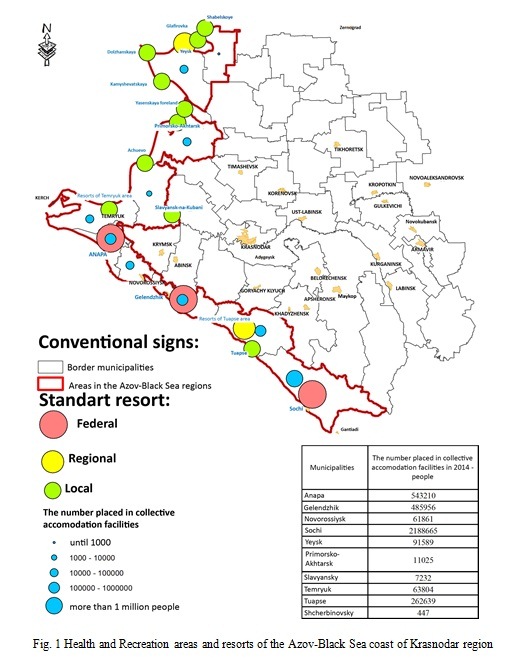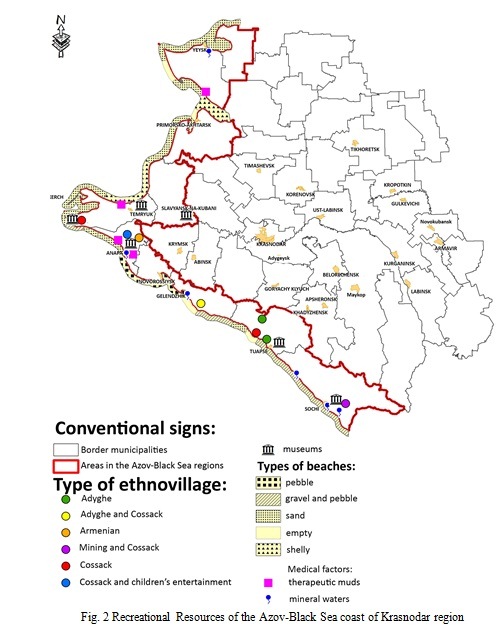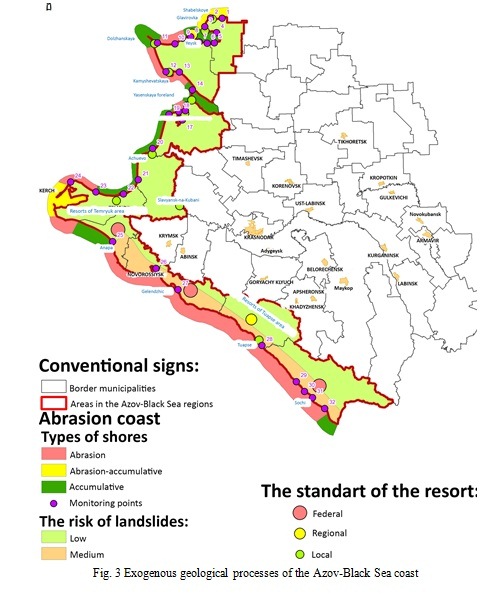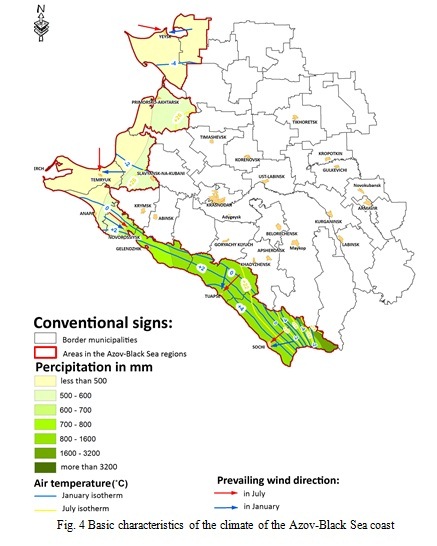Russian Federation
BISAC NAT010000 Ecology
BISAC NAT045050 Ecosystems & Habitats / Coastal Regions & Shorelines
BISAC NAT025000 Ecosystems & Habitats / Oceans & Seas
BISAC NAT045030 Ecosystems & Habitats / Polar Regions
BISAC SCI081000 Earth Sciences / Hydrology
BISAC SCI092000 Global Warming & Climate Change
BISAC SCI020000 Life Sciences / Ecology
BISAC SCI039000 Life Sciences / Marine Biology
BISAC SOC053000 Regional Studies
BISAC TEC060000 Marine & Naval
This article is devoted to the estimation of recreational potential based on the dynamic processes, natural and anthropogenic factors of the Azov-Black Sea coast of Krasnodar region as an example. Bioclimatic figures are considered as the dynamic processes and natural factors, the degree of the development of exogenous geological processes. Anthropogenic factors are represented by the multi aspect business activities in the coastal zone.
recreational potential, recreational natural management, coastal ecosystems, the Azov-Black Sea coast, Krasnodar region.
In up to date sircumstances more attention is given to recreational nature management. This is quite justified, because the efficient use of the recreational areas can be a source of funds to supplement the budget at a certain stage of an economic development of regions.
The presence of the recreational potential on the territories is an important condition for the tourism development. The recreational potential of the territory is often stands for the totality of natural, cultural, historical and socio-economic conditions for the organization of recreational activities in a particular area.
The recreation potential very often refers to the existence of certain objects that are unique or at least attractive not only for locals. The recreational potential of the territory is very variable and depends on the specific socio-cultural knowledges it is located in. Identification of the existing tourism potential is not the most difficult task, because nowadays almost every old-cultivated territory has monuments of history and culture, natural protected sites, including a detailed information about the objects of social and cultural facilities - museums, hotels, restaurants, health resorts and recreation centers, etc. [1].
There are some complex methods of exploration of recreational resources, including their identification and a natural, historical, cultural potential, infrastructure and personnel detection. Revealing of recreational resources is primarily associated with the study of natural and cultural systems and human resources to involve in some tourist and recreational activities. Several common approaches to the evaluation of recreational resources have been currently developed, in this case the following is primary evaluated: the functional serviceability for a particular type of tourism (technology evaluation); the degree of comfort (physiological evaluation); aesthetic qualities (psychological evaluation) [2]. An economic and environmental evaluation, by the way, integrated in the definition of a resourse of recreational value. The evaluation of dynamic natural and anthropogenic processes on the level of the recreational potential of the territory is of a key importance lately. It is not enough to detect the presence of certain recreational resources to assess the recreational potential of the territory, it is important to identify and predict the impact of these resources in terms of different types of geosystems. The evaluation of the recreational potential of coastal geosystems and its efficient use is one of the relevant problems of modern natural management [3].
The target of research in this case is the Azov-Black Sea coast of Krasnodar region.
In order to clarify the understanding of the nature and description of the study area, different approaches to the definition of coastal areas should be taken into account. The main difficulties of the conceptual construct of the coastal zone are determined by two factors:
1. The absence of a clear legislative framework, which contains clear terms such as coastal zone, its components, coastal zone management, etc.;
2. The lack of a uniform terminology in the science sidelines concerning the coastal zone (geomorphology, biology, geology, management and so on.). Moreover, the ambiguous use of certain terms in different fields of science. For example, there is a term "waterside or littoral zone" in geology, geomorphology, coast survey and it is "coastal zone" in biology and management.
The territory and boundaries of this area differ from each other sometimes fundamentally due to the variety of applied approaches.
In general, coastal areas can be described as complex spatial-territorial objects, which include geographical, ecological, economic and social components.
The definition that reflects the essence of the concept of "coastal area" or "coastal zone", was proposed by the European Commission: coastal zone is a contact area of land to the sea, including natural systems both the coast and the adjacent marine area within the boundaries, allowing to provide ecologically balanced development of coastal areas, conservation of coastal and marine landscapes and ecosystems from pollution and destruction, a territory with a limited and regulated regime of economic and other activities [4].
A "coastal zone" term had already appeared in the 60-70-s of the XX century in developed coastal countries and a furhte term "integrated coastal zone management" as a result. We can say now that the study of integrated coastal zone management contributes to understanding the relationships formed within the socio-economic system of the coastal zone, as well as the conditions in which methods and approaches of planning and management have been developed.
There is no definition of coastal areas in the Russian Federation regulation. The Water Code of the Russian Federation reveals the concept of the water protection zone, which can be considered as a component of the territory (land) of the coastal zone.
Many authors have noted the concept of coastal zone in russian encyclopedia is firstly defined with the help of the principle formulated by the United States and outlined in the Law on Coastal Zone Management US, and secondly, according to the principles set out in the Model Law of the EU Sustainable management of coastal zones. Analyzing different interpretations offered by these regulations we can generally conclude that in this study a coastal zone (territory) is advisable to be regarded as the geographical area consisting of both land and sea side, as well as the territory of the local administrative units adjacent to sea. Land boundaries are determined by the coastal territory at such a distance from the sea, which provides control over the relevant area of the land, the use of which has a direct and significant impact on coastal waters. In the process of determining the boundaries it is also important to mention the relationship factors of activity in the coastal zone, the exchange of information on this issue, the possibility of formation of mechanisms of good governance, based on clear and common understanding by all participants of the process goals and objectives of this complex system.
Increasing anthropogenic pressure on the ecosystem of the Black and Azov seas associated with increased recreational activities in coastal areas, has a negative impact on the biological quality of water resources of the basin [5]. Industrial development of the coastal regions, increasing number of urban and coastal settlements, proliferation of resorts and the increase in the volume of industrial waste water, increasing the volume of congestion in ports and transportation of oil, fertilizer and other mineral resources, the growth of shipping, the expansion of sea ports, construction of new terminals, underwater exploration and production of oil and gas require the adoption of necessary measures to prevent the negative consequences of these changes [6].
Azov-Black Sea coast of the Rostov Region and Krasnodar Region is a unique natural complex with rich flora and fauna, within which the huge industrial and social potential is concentrated. The main specialization sectors of this areas are agriculture, recreation and port facilities. (Fig.1, Fig.2)
The coastal zone is the zone of important public interests. Natural management must be controlled strictly by the state here. The clash of interests of various branch departments, financial giants at the time of deficit at the all-Russian coastal areas leads to the competition functions; many natural resources are extremely sensitive to human impact, which may jeopardize the very existence of the most valuable natural complexes. Therefore, coastal resources should be involved in the use on the basis of federal programs, and integrated management, which should be based on scientific data [7].
Azov-Black Sea coast of a Krasnodar region seaside is a contact zone with the length of 950 km. Azov-Black Sea coast border is limited by the administrative border of the land of the coastal cities and districts. Thus, Azov-Black Sea coast is not a narrow strip of the land directly fitting to the sea and its width varies from 10 to 50 km [8].
At the same time, the study has found that the territory of the Azov-Black Sea coast of Krasnodar region is the subject to both anthropogenic impact and to the objective exogenous processes (Fig.3).


Fig. 2 Recreational Resources of the Azov-Black Sea coast of Krasnodar region

Fig. 3 Exogenous geological processes of the Azov-Black Sea coast
Based on the above mentioned, the target of the research means a totality of the subjects of the administrative-territorial division in the structure shown in Table 1.
Table 1 – Municipal structures of study area
|
№ |
Municipal structure |
Administrative center |
Square kilometers |
|
1 |
Shcherbinovsky region |
Staroshcherbinovskaya |
1377,1 |
|
2 |
Yeisky |
Yeisk |
2120,3 |
|
3 |
Primorsko-Akhtarsky region |
Primorsko-Akhtarsk |
2503,6 |
|
4 |
Slavyansk-on-Kuban region |
Slavyansk-on-Kuban |
2198,6 |
|
5 |
Temryuk region |
Temryuk |
1956,5 |
|
6 |
Resort town Anapa |
Anapa |
981,9 |
|
7 |
Novorossiysk |
Novorossiysk |
834,9 |
|
8 |
Resort town Gelendzhik |
Gelendzhik |
1227,5 |
|
9 |
Tuapsinsky region |
Tuapse |
2399,2 |
|
10 |
Resort town Sochi |
Sochi |
3506,1 |
However, these exogenous geological processes are very irregular. The activity of slope processes increases in the sub-mountain areas of the region including the coastal zone. The part of the study area (most of the Black Sea region) goes in the zone of mudflow hazard. The process of coastal erosion has a great impact on recreation in the coastal zone and the absence of shore protection can lead to loss of beach areas. The monitoring of hazardous exogenous processes should be carried out continuously.
According to ecological and phytocenotic characteristics of coastal and adjacent areas flora and the studied recreation area is characterized by a high degree of diversity and exoticism of species and is attractive (including consumer tourism).
Bioclimatic rate of the Azov-Black Sea coast of Krasnodar region has been studied: the mode of solar radiation, atmospheric circulation, wind and thermal regime, the regime of humidity and precipitation (Fig.4). The first findings show that the study area belongs to the zone of discomfort according to some bioclimatic parameters and it should affect the specific features of the organization of some recreational activities.
Some synoptic phenomena have been identified with the help of the long-term recurrence of wind directions analysis: northeasterly strong winds reaching hurricane force (Novorossiysk, Gelendzhik, Anapa); the increase in repeatability of western moisture-laden flows in summertime increases greatly the amount of precipitation on the Black Sea coast, resulting in floods and overflowing; surges on the Azov coast; squally wind in autumn and winter period on the Taman peninsula. The estimation of wind-wave flows of the coastal zone has been conducted. The analysis of the factors influencing the development of the disturbances in the study area has been carried out. Zones of stagnation and siltation have been detected. Zones of active coastal erosion (due to wind conditions), stagnant zones and siltation have been educed. The recurrence of great flurry periods as a limiting factor for the beach-bathing recreation has been investigated.
There is a reallocation of tourist flows associated with the changes in geo-economical and geopolitical situation. Right from the beginning of economic sanctions of western countries deter the desire of Russian tourists to take holidays abroad. Attraction to the Russian resorts is artificially enhanced by the growth of the foreign currencies’ rate against the Russian ruble, which reduced significantly the purchasing power of the Russian citizens in relation to the proposed foreign travel products. The accession of the Republic of Crimea to the Russian Federation transformed the market of tourist services of the Krasnodar region. The expected outflow of tourists did not happen due to problems of transport infrastructure (the absence of a bridge across the Kerch Strait and the low through-flow rate of the ferry line). At the moment the situation is redoubled by the unstable situation in the Crimea on the border territory with Ukraine and energy blockade of Crimea.

Fig. 4 Basic characteristics of the climate of the Azov-Black Sea coast
The escalation of the conflicts with Western countries and their policy towards the Russian Federation only strengthened the position of Russian tourists in the choice of their holiday destinations in 2014, 2015 and 2016. All these processes have led to the significant growth of the holidaymakers flow taken in coastal areas of Krasnodar region, which led to a considerable load increase not only on the natural recreational resources but also on the subsystems serving the tourist and recreational sector tourism infrastructure in particular. Thus, the observed processes can lead to irreversible effects, including the digression of natural systems, and therefore it is advisable to take immediate steps to redistribute the resulting load.
ACKNOWLEDGEMENTS
Supported by grant number 15-12-23010 (p) of the Russian Humanitarian Science Foundation and the Administration of Krasnodar Region
1. Kudelya E.V., Volkova T.A., Anisimova V.V., Karpova Y.I., 2013 Some of the defining characteristics of the recreational potential of the territory // Resort and recreation complex in the system of regional development: innovative approaches.2013. T. 1. pp. 176-178.
2. Mishchenko T.A. The impact of tourism resources in the development of regional tourism and the problem of their recreational evaluation // Geographical research Krasnodar Territory: collection of scientific works. Krasnodar, 2009. pp. 237-241.
3. Lipilin D.A., Volkova T.A., Mishchenko A.A., Minenkova V.V. Estimation of recreational potential of protected areas of the Western Caucasus via kosmosemok methods (for example, Tuapse district) // global scientific potential. 2015. № 9 (54). pp. 90-97.
4. Kropinova E.G., Afanasyev E.P. Sustainable development of coastal areas as a basis for integrated coastal zone management // Herald Baltic Federal University. Kant. 2014. Vyp. 1. pp. 140-147
5. Volkova T.A., Filobok A.A., Belikov M.Y., Pinchuk D.S, Kalustova I.S. Sustainable development and vulnerability of coastal ecosystems Azov-Black Sea coast of Krasnodar region // Ecology and natural resources: applied aspects VI International Scientific and Practical Conference. Ufa. 2016. pp 82-89.
6. Minenkova V.V., Voronina V.V., Filobok A.A. Azov-Black Sea coast of Russia in the structure of the new geopolitical space in the globalization // Polimasshtabnye system "center-periphery" in the context of globalization iregionalizatsii: theory and practice of socio-geographical research: Proceedings of the International Conference (Sixth Annual Scientific Assembly ARGO). Simferopol. 2015. pp. 305-310.
7. Chistyakov V.I., Filobok A.A. Sustainable urban development of the Azov-Black Sea coast of Russia in the new geo-economic conditions. Monograph - Krasnodar. 2008. - 308 pp.
8. Filobok A.A., Voronina V.V., Kudelya A.V. Transformation of population settlement of in the russain mountainius Black sea coastal area in post soviet period // The Caucasus and the Alps in the comparative aspect: Proceedings on the materials of the joint summer school "Caucasus and the Alps in the comparative aspect." Krasnodar. 2014. pp. 93-100.







